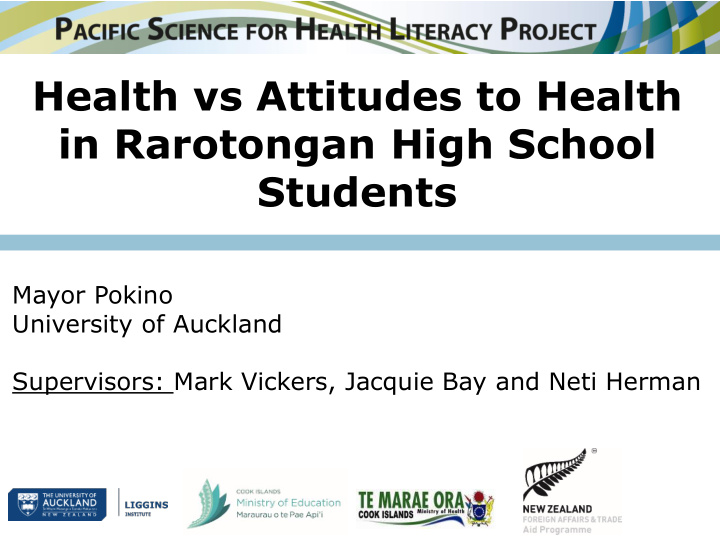



Health vs Attitudes to Health in Rarotongan High School Students Mayor Pokino University of Auckland Supervisors: Mark Vickers, Jacquie Bay and Neti Herman
NCDs in the Cook Islands Percentage of deaths in the Cook Islands 36% die before age 60 26% 1.3 fold higher than average rates globally for low-and middle-income 74% countries NCDs Others World Health Organisation. Non communicable diseases country profiles 2011: Cook Islands. Cook Islands; 2011.
Cook Islands Adult NCD Risk 2004-2015 %Adults aged 25-64 years NCD Risk Factors 2004 2015 (n=2,629) (n=1,271) Overweight 88.5/61.4 91.1/72.2 Hypertension 33.2 32.9 Elevated blood glucose 23.6 26.8 Elevated blood cholesterol 75.2 50.9 Fruit and vegetable consumption < 2 fruit and 3 81.8 84.8 vegetable servings daily Low daily physical activity 75.3 33.0 Cook Islands Ministry of Health, NCD STEPS Fact sheet report, 2011, 2016
Overweight Children and Young People in the Cook Islands 2003 - 2015 Between 2003 and 2015, overweight in 5 to 12 43.4% 50 years old increased from 12.6% to 21.3% 40 % 13 to 18 years-olds, 30 Overweight increased from 28.4% to 43.4% 20 STEPS 2015 10 18 – 24-years old Overweight: 87.2% 0 Obesity: 68.5% 2003 2007 2011 2015 Primary School Age Secondary School Age Cook Islands Ministry of Health. School physical health examination data: 2003 – 2015.
Adolescence: Window of Opportunity o Defined by World Health Organisation as young people between 10 – 19 years o Adolescence is the period for the establishment of lifelong behaviours o Associations between health-related behaviours in adolescence and increased risk of NCDs in adulthood o Adolescence - an optimal time for interventions to prevent future risk of NCDs Bay JL, Morton SM, Vickers, MH. Realizing the potential of adolescence to prevent transgenerational conditioning of Noncommunicable disease risk: multi-sectoral design frameworks. Healthcare, (4): 39. 2016 Proimos J, Klein JD. Noncommunicable diseases in children and adolescent. Pediatrics Perspective . 2012
Aim and methods Aim • To investigate associations between NCD risk factors and health/lifestyle related knowledge, attitudes and behaviours in Rarotongan adolescents prior to participation in Pacific Science for Health Literacy Project learning programmes Method • Cross sectional study: utilizing two sets of data • Adolescence health data from Ministry of Health biannual school physical health examinations • Matched with data examining knowledge, attitudes, and behaviour data from the Pacific Science for Health Literacy Project • Cohort of 173 Year 9 students across the three main colleges, 163 consented, 144 students have available health data
Knowledge, attitudes and behaviour data Knowledge Attitudes Behaviour
Adolescent Health Data 1. Weight Body Mass Index (BMI) 2. Height Waist-to-Height Ratio 3. Waist circumference 4. Blood pressure 5. Blood lipids 6. Blood glucose 7. Cholesterol
Cross sectional study Knowledge, ? Adolescence attitudes NCD risk and factors behaviour
Summary 36% of NCD-related deaths before age 60 • • Health-related behaviours established during adolescence stage more likely to increase risk of NCDs in adulthood • Adolescence a critical window of opportunity for prevention – focus NCD intervention on adolescents • Baseline study
Acknowledgements • Students, parent and teachers • Mark Vickers • Jacquie Bay • Neti Herman • Ministry of Health • Ministry of Education • Pacific Science for Health Literacy Project • New Zealand Health Research Council • New Zealand Aid
Recommend
More recommend